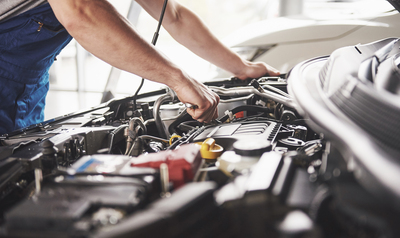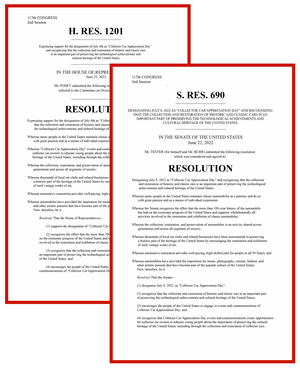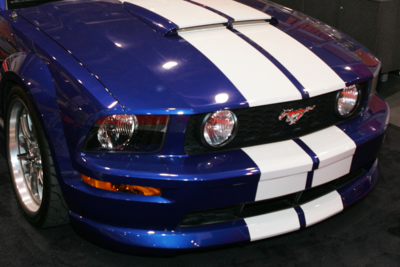LEGISLATIVE AND TECHNICAL AFFAIRS
Law and Order
The Year in Review
By Daniel Ingber
The laws and regulations that govern SEMA members affect the way automotive specialty-equipment products are made, distributed, and marketed. The responsibility of the SEMA government affairs office is to stay on top of all relevant state and federal legislation and regulations and advocate for industry positions to ensure the best possible outcome for SEMA’s membership. The following are a few examples of critical legislative/regulatory issues addressed by the SEMA government affairs team over the past year.
FEDERAL UPDATE
 Right to Repair: U.S. Rep. Bobby Rush (D-IL) introduced the “Right to Equitable and Professional Auto Industry Repair (REPAIR) Act.” The SEMA-supported legislation (H.R. 6570) aims to ensure the preservation of consumer choice, a fair marketplace, and the continued safe operation of the nation’s 288 million registered passenger and commercial motor vehicles. As vehicle technology continues to advance, new barriers to a competitive auto servicing marketplace are emerging. These barriers limit consumer choice in where to service, repair and modify motor vehicles and increase servicing costs. The REPAIR Act, if enacted into law, will reduce these barriers, putting consumers’ interests first. The bill is backed by SEMA, the Auto Care Association, the Automotive Aftermarket Suppliers Association and the CAR Coalition.
Right to Repair: U.S. Rep. Bobby Rush (D-IL) introduced the “Right to Equitable and Professional Auto Industry Repair (REPAIR) Act.” The SEMA-supported legislation (H.R. 6570) aims to ensure the preservation of consumer choice, a fair marketplace, and the continued safe operation of the nation’s 288 million registered passenger and commercial motor vehicles. As vehicle technology continues to advance, new barriers to a competitive auto servicing marketplace are emerging. These barriers limit consumer choice in where to service, repair and modify motor vehicles and increase servicing costs. The REPAIR Act, if enacted into law, will reduce these barriers, putting consumers’ interests first. The bill is backed by SEMA, the Auto Care Association, the Automotive Aftermarket Suppliers Association and the CAR Coalition.
RPM Act: The Recognizing the Protection of Motorsports Act (RPM Act) has been reintroduced in the 117th U.S. Congress. The bipartisan, pro-motorsports, pro-business legislation will clarify that it is legal under the Clean Air Act (CAA) to make emissions-related changes to convert a street vehicle into a dedicated race car. It will also confirm that it is legal to produce, market and install racing equipment. In 2015, the U.S. Environmental Protection Agency (EPA) issued a draft rule stating that such conversions were illegal, as were products used to make the conversions. The EPA withdrew the draft rule following a huge, SEMA-led public outcry but still stands by this controversial interpretation of the CAA. The legislation (H.R. 3281/S. 2736) is sponsored by Representatives Patrick McHenry (R-NC) and Raul Ruiz (D-CA) and Senators Richard Burr (R-NC) and Jon Tester (D-MT). The Senate Environment and Public Works (EPW) Committee held a hearing on the bill in September. The bill was being considered by the Senate EPW and House Energy & Commerce Committees at the time of publication.
California Ban on Sale of New ICE-Powered Cars: The California Air Resources Board (CARB) voted to finalize a SEMA-opposed rule to implement California Governor Gavin Newsom’s 2020 executive order to phase out the sale of new diesel- or gas-powered cars in the state by 2035. The rule requires 35% of new cars, SUVs and small trucks sold to be zero-emissions starting in 2026, increasing to 68% in 2030 and 100% in 2035. In 2022, zero-emissions vehicles made up about 16% of new cars sold in California. The rule also sets durability, warranty, and other provisions on zero-emissions vehicles. The newly adopted regulations could lead to 17 other states that have often followed all or part of California’s previous clean-car rules adopting similar proposals. The sale of used cars would not be affected under the proposal, and it would not force the current fleet of diesel- or gas-powered vehicles off the road.
 Outdoor Recreation: The U.S. Senate Energy and Natural Resources Committee unanimously passed the bipartisan “America’s Outdoor Recreation Act of 2022,” S. 3266, a package of public lands and recreation legislation designed to increase access to the outdoors, streamline and simplify land management processes, and improve America’s recreation infrastructure. The legislation includes provisions to improve the permitting process for outfitters and guides who work on public lands, and it streamlines the process and expenses associated with obtaining special recreation permits. The bill includes a travel management provision that directs the U.S. Bureau of Land Management (BLM) and U.S. Forest Service to make maps available to the public depicting where vehicles are allowed and where they are prohibited, as well as to update them periodically to ensure the maps do not become outdated. In carrying out this section, agencies are required to increase opportunities for motorized and non-motorized access and experiences on federal land.
Outdoor Recreation: The U.S. Senate Energy and Natural Resources Committee unanimously passed the bipartisan “America’s Outdoor Recreation Act of 2022,” S. 3266, a package of public lands and recreation legislation designed to increase access to the outdoors, streamline and simplify land management processes, and improve America’s recreation infrastructure. The legislation includes provisions to improve the permitting process for outfitters and guides who work on public lands, and it streamlines the process and expenses associated with obtaining special recreation permits. The bill includes a travel management provision that directs the U.S. Bureau of Land Management (BLM) and U.S. Forest Service to make maps available to the public depicting where vehicles are allowed and where they are prohibited, as well as to update them periodically to ensure the maps do not become outdated. In carrying out this section, agencies are required to increase opportunities for motorized and non-motorized access and experiences on federal land.
ADAS Technology: The National Highway Traffic Safety Administration (NHTSA) proposed adding four more advanced driver-assistance system (ADAS) technologies to its five-star safety rating program: lane-keeping support, pedestrian automatic emergency braking, blind-spot warning and blind-spot intervention. NHTSA’s New Car Assessment Program (NCAP) already includes four ADAS technologies: forward collision warning, lane-departure warning, crash imminent braking, and dynamic brake support. The agency is also seeking to update and strengthen the testing procedures and performance criteria for the four ADAS technologies currently in NCAP. SEMA submitted comments aimed at protecting consumers’ ability to modify their ADAS-equipped vehicles.
 Collector Car Appreciation Day: The 13th annual Collector Car Appreciation Day (CCAD) took place on Friday, July 8, 2022. Both the U.S. Senate and the House of Representatives introduced resolutions (H. Res. 1201/S. Res. 690) to focus attention on the vital role automotive restoration and collection plays in American society. Thousands of Americans gathered at car cruises, parades and open houses at SEMA-member companies to celebrate the nation’s automotive heritage. The day is also international in scope, as many Canadian provinces passed resolutions and hosted events. The next CCAD is set for July 14, 2023.
Collector Car Appreciation Day: The 13th annual Collector Car Appreciation Day (CCAD) took place on Friday, July 8, 2022. Both the U.S. Senate and the House of Representatives introduced resolutions (H. Res. 1201/S. Res. 690) to focus attention on the vital role automotive restoration and collection plays in American society. Thousands of Americans gathered at car cruises, parades and open houses at SEMA-member companies to celebrate the nation’s automotive heritage. The day is also international in scope, as many Canadian provinces passed resolutions and hosted events. The next CCAD is set for July 14, 2023.
Supreme Court Ruling: In a 6-3 decision, the U.S. Supreme Court held that Congress did not grant the EPA the authority to devise carbon emissions caps for power plants that would shift the way they generate energy away from coal. The case, West Virginia vs. EPA, is unusual in that it centers around the 2015 Clean Power Plan that never went into effect. The Obama Administration plan was blocked in court and a subsequent Trump Administration plan was struck down. This decision, while limiting how the EPA can use its authority to reduce carbon dioxide emissions from power plants, has no effect on current EPA regulation of aftermarket performance products or mobile source emissions. It could have future implications for how much authority government agencies have to enact substantial policy without congressional approval.
Court Rules Racing Coalition Lacks Standing to Challenge EPA: The United States Court of Appeals for the District of Columbia dismissed a lawsuit brought by the Racing Enthusiasts and Suppliers Coalition (RESC) against the EPA for lack of standing. The suit, brought by a coalition of racing enthusiasts and aftermarket parts business owners, challenged the 2015 EPA interpretation of the Clean Air Act that motor vehicles designated for street use cannot be converted into dedicated race vehicles. Although the EPA abandoned efforts to make this policy a formal regulation in 2016, the agency still maintains the practice of modifying the emissions system of a motor vehicle for the purpose of converting it for racing is illegal. The court found that EPA’s 2016 rule did not create a challengeable rule and that RESC had not shown they were injured by the EPA’s rule. The court did not discuss in any detail nor decide the merits of the case concerning the EPA’s authority under the Clean Air Act to regulate dedicated race vehicles that are converted from street vehicles.
Tariffs: SEMA is working with several industry coalitions to oppose tariffs on a variety of worldwide products and materials. SEMA submitted comments to the International Trade Commission (ITC) as it evaluates the impact of Section 232 Steel and Aluminum tariffs and Section 301 tariffs on goods imported from China on the U.S. economy. The comments laid out how both tariffs have negatively impacted SEMA-member businesses. SEMA supports the swift removal of both the Section 232 and 301 tariffs. The U.S. Congress directed the ITC to conduct the investigation and issue a report by March 2023 on the impact of the tariffs on U.S. industries. The following is a summary of specific tariffs.
Steel and Aluminum: U.S. officials reached agreements with the European Union, Japan and the United Kingdom to end the tariffs on steel imports. The European Union and United Kingdom agreements also removed the tariffs on aluminum. These countries agreed to establish quota systems for the metal imports. The U.S. government imposed global tariffs on steel (25%) and aluminum (10%) beginning in June 2018 under Section 232 of U.S. trade law, citing that dependence on foreign sources posed a national security threat. Argentina, Australia, Brazil, and South Korea were excluded based on quotas, and Canada and Mexico were eventually excluded based on the U.S.–Mexico–Canada Agreement. The tariffs generally apply to processed raw materials (steel/aluminum plate, sheets, bars, etc.) but not finished products (wheels, exhaust systems, etc.). However, tariffs were imposed on bumper stampings and a few other finished products due to an import surge.
China Tariffs: The Office of the U.S. Trade Representative (USTR) began a formal review process of the Section 301 tariffs on goods imported from China that could lead to the continuation, modification, or end to the tariffs. When Section 301 tariffs are imposed, the law requires the USTR to pursue a review at the beginning of the fourth year, which has just occurred. Several domestic industries which have benefited from the tariffs have requested their continuation. The USTR will now seek public comments and then make a recommendation on whether to continue, modify, or end the tariffs. In 2018, the USTR instituted a Section 301 investigation of Chinese trade practices and imposed $50 billion in tariffs on a variety of goods on Lists 1 and 2, including miscellaneous metal and rubber parts. After China responded with retaliatory tariffs, the United States imposed the additional List 3 and 4a tariffs. The List 3 tariffs apply to most auto parts. They began at 10% in September 2018 but increased to 25% in May 2019.
Low Volume Replica Vehicle Manufacturers: NHTSA finalized a regulation to implement the SEMA-led Low Volume Motor Vehicle Manufacturers Act. SEMA worked with Congress to amend federal law to enable small auto manufacturers to produce completed replica vehicles under a streamlined regulatory structure that reflects the distinctly different business model of this niche industry. NHTSA’s regulations offer a business-friendly pathway for companies to begin producing up to 325 such replica cars a year. Replicas must resemble production vehicles manufactured at least 25 years ago to qualify.
Combatting Counterfeit Goods: The SEMA-supported “INFORM Consumers Act,” H.R. 5502, passed the U.S. House of Representatives as part of the “America Creating Opportunities for Manufacturing, Pre-Eminence in Technology, and Economic Strength Act of 2022” (America COMPETES Act), H.R. 4521. The INFORM Consumers Act is designed to protect Americans from criminals who sell counterfeit and stolen goods through online marketplaces. The legislation would require high-volume third-party sellers to disclose the full name of the seller or company, its business address, and its contact information, among other requirements. SEMA is part of the Buy Safe America Coalition, a diverse group of retailers, consumer groups, manufacturers, intellectual property advocates and law-enforcement officials who support efforts at all levels of government to protect consumers and communities from the sale of counterfeit and stolen goods.
Federal Bills Signed into Law: This year President Biden signed into law two bills that will impact the automotive industry. The “Infrastructure Investment and Jobs Act” provides $550 billion in new funding over five years for all modes of transportation, water, power and energy, public lands, and broadband. The law also directs NHTSA to issue several rules to promote new vehicle safety measures. These include mandating that all new vehicles have monitoring systems to detect drunk drivers as early as 2026; rear-seat reminders to alert parents if a child is left in the back seat as early as 2025; and automatic emergency braking and lane-
departure warnings, although no date was set for this rule. Most automakers joined a voluntary agreement under the Obama Administration to install automatic emergency braking equipment on a majority of their models by September 2022.
The second bill, the “Inflation Reduction Act of 2022,” included several automotive provisions, including the elimination of the 200,000-vehicle-per-automaker cap on the current $7,500 per-vehicle tax credit for consumers who purchase new battery-electric, hybrid plug-in and fuel-cell vehicles at the point of sale. The bill also provides a tax credit of up to $4,000 for the purchase of used vehicles listed above. The tax credit can only be used on cars that cost up to $55,000 and pickups, SUVs and vans that cost up to $80,000. It can only be claimed by buyers with incomes up to $300,000 for joint filers. The tax credit sets increasing sourcing requirements for the critical minerals used in EV batteries to be extracted or processed in the United States or in a country where the United States has a free trade agreement in effect or from materials that were recycled in North America (40% in 2024, 80% in 2027 and 100% by 2029).
E15 Ethanol: The EPA announced it will issue a temporary waiver to allow for the summertime sale of gasoline with up to 15% ethanol (E15). Currently, E15 cannot be sold between June 1 and September 15 due to fuel-volatility concerns that higher blends of ethanol combined with warmer temperatures may lead to increased ground-level ozone formation and smog. Ethanol, especially in higher concentrations such as E15, can cause metal corrosion and dissolve certain plastics and rubbers in older automobiles that were not constructed with ethanol-resistant materials and certain specialty high-performance equipment installed on newer vehicles. SEMA opposes the expansion of E15 gasoline sales as there may not be enough protections to guard against misfuelling.
Federal Headlight Standard: NHTSA issued a final rule amending the federal motor vehicle safety standard regulating lighting equipment (FMVSS No. 108) to include performance-based standards for adaptive driving beam (ADB) headlights. ADB headlights or “smart headlights,” which have been permitted on vehicles in Europe since 2006, operate as high-beam headlights and automatically dim portions of the beam when oncoming vehicles are detected by sensors. The bipartisan infrastructure bill that was signed into law in 2021 mandated that NHTSA update FMVSS No. 108 to allow for this technology. The final rule permits the use of ADB headlights on new vehicles as well as aftermarket installation of these systems, both for replacing original equipment and replacing a non-ADB headlight.
Ban on Chrysotile Asbestos: The EPA has issued a proposed rule to ban all manufacturing, processing, importation and commercial distribution of six categories of products containing chrysotile asbestos, which covers all of its current uses in the United States. This includes sheet gaskets, brake blocks, aftermarket automotive brakes/linings and other vehicle friction products. Chrysotile asbestos is the only known form of asbestos currently imported into the United States. The proposed prohibition of asbestos use in brake blocks, aftermarket automotive brakes and linings, other vehicle friction products, and other gaskets for commercial use would take effect 180 days after the EPA issues a final rule.
California Prop 65: California’s Office of Environmental Health Hazard Assessment (OEHHA) did not complete the regulatory process for its proposed amendments to the Proposition 65 short-form warning within the allotted time and allowed the rulemaking to lapse. OEHHA stated it intends to start the regulatory process again with a new proposal to update the short-form warning label and will consider the comments on the previous proposal into this process. SEMA submitted comments opposing the initial proposal and the subsequent modifications, as the new regulations would have mandated that at least one chemical associated with cancer and/or one chemical known to be a carcinogen be identified on the short form. Prop 65 doesn’t stop anyone from selling their products regardless of what chemicals they contain. It simply requires consumer warning labels under certain circumstances. The current short-form warning does not identify a specific chemical(s) while the long-form warning requires identification of a specific chemical(s).
California Oceano Dunes OHVs: SEMA and its allies in the motorized recreation community are working to protect off-highway vehicle (OHV) usage at the Oceano Dunes State Vehicular Recreation Area (SVRA), which is California’s only OHV park on the Pacific Ocean. It is located about two hours northwest of Los Angeles near San Luis Obispo. Oceano Dunes SVRA became a state park in 1974 and has been under threat of closure for many years, primarily by groups that object to motorized recreation based on environmental arguments that off-roading causes more airborne particulate matter (dust) and/or threatens plants and animals.
California State Parks and the California Coastal Commission (CCC) have been locked in a conflicting jurisdictional dispute over Oceano Dunes. The CCC contends that it has primacy with respect to environmental concerns, while State Parks cites a mandate from the state legislature to manage the area for OHV use.
In response to the CCC passing a March 2021, measure to shut down OHV access within three years, SEMA and several other off-road groups have challenged the CCC decision in lawsuits filed in California State Superior Court for San Luis Obispo County. The court held a preliminary hearing in January, and a trial is scheduled for March 2023.
STATE UPDATE
 Alaska—License Plate: Alaska Governor Mike Dunleavy signed into law SEMA-supported legislation to allow the display of only a single, rear-mounted license plate for all passenger vehicles. Under the previous law, vehicles were required to display two license plates. The new law is estimated to save the state more than $300,000 per year.
Alaska—License Plate: Alaska Governor Mike Dunleavy signed into law SEMA-supported legislation to allow the display of only a single, rear-mounted license plate for all passenger vehicles. Under the previous law, vehicles were required to display two license plates. The new law is estimated to save the state more than $300,000 per year.
California—Automobile Cruising: The California legislature passed a SEMA-supported resolution celebrating the history and culture associated with automobile cruising. This resolution encourages local officials and law enforcement to work with local car clubs to conduct safe cruising events.
Kansas—Antique Vehicles: Governor Laura Kelly signed into law SEMA-supported legislation to allow antique vehicles which are 60 years old or older the ability to forego a VIN inspection when applying for a title. The new law expands eligibility of these vehicles for certain titling procedures by allowing only a bill of sale as proof of ownership and an application. Prior to the new law, only antique vehicles with a model year of ’50 or earlier could forego the VIN inspection when applying for a title.
 Arizona—Restoration: Arizona Governor Doug Ducey signed into law SEMA-supported legislation to allow full restoration of pre-’81 vehicles, including temporary removal of the vehicle identification number (VIN) when necessary. The new law allows for the removal and reinstallation of a VIN if the vehicle was manufactured before ’81 and if the removal and reinstallation is reasonably necessary for repair or restoration.
Arizona—Restoration: Arizona Governor Doug Ducey signed into law SEMA-supported legislation to allow full restoration of pre-’81 vehicles, including temporary removal of the vehicle identification number (VIN) when necessary. The new law allows for the removal and reinstallation of a VIN if the vehicle was manufactured before ’81 and if the removal and reinstallation is reasonably necessary for repair or restoration.
Kansas—Restoration: Governor Laura Kelly signed into law SEMA-supported legislation to allow full restoration of antique vehicles, including temporary removal of the vehicle identification number (VIN) when necessary. This bill allows for the removal and reinstallation of a VIN if it is reasonably necessary for repair or restoration. Previously, restorers who intentionally removed or altered a VIN, regardless of reason, were guilty of a felony and the vehicle was subject to seizure and destruction by law enforcement.
Maryland—Emissions: The Maryland legislature failed to advance SEMA-opposed legislation to enact a biennial $14 fee on motor vehicles that are exempt from the state’s Vehicle Emissions Inspection Program, including historic vehicles and street rods.
Minnesota—Ethanol: The Minnesota legislature failed to advance two SEMA-opposed bills to increase the standard biofuel blend in gasoline to 15% ethanol (E15). One bill had an exemption for retailers who sell less than 500,000 gallons of gasoline/biofuel per year who are not equipped to store and dispense E15, while another bill had an exemption for retailers who sell less than 300,000 gal. of gasoline/biofuel per year.
New Hampshire—Exhaust: Governor Chris Sununu signed into law SEMA-supported legislation to allow the use of side-mounted exhaust on antique vehicles. The new law specifies exhaust discharge points (must be to the rear edge of either door if the vehicle has two doors and to the rear edge of either rear door if the vehicle has four doors) and such system directs exhaust gas away from the vehicle.
Oklahoma—Military Vehicles: Governor Kevin Stitt signed into law SEMA-supported legislation to allow the registration and titling of former military surplus vehicles for on-road use. The new law defines a military surplus vehicle as a vehicle less than 35 years old and was manufactured for use in either the U.S. Armed Forces or any country that was a member of the North Atlantic Treaty Organization at the time the vehicle was manufactured.
Pennsylvania—Motorsports: Governor Tom Wolf signed into law SEMA-supported legislation to create an exemption for motor vehicles or a motor-vehicle combination from perceived “commercial” activity provided that the vehicle is being used to transport another vehicle to or from an amateur competitive event, whether or not the owner displays sponsorship markings.
Utah—Military Vehicles: Utah Governor Spencer Cox signed into law SEMA-supported legislation to exempt military vehicles from displaying a license plate. The new law requires a license plate to be carried inside the vehicle and ready for inspection by law enforcement upon request.
Virginia—YOM Plates: Virginia Governor Glenn Youngkin signed into law SEMA-supported legislation expanding year-of-manufacture (YOM) license plates for vehicles registered as antiques to include plates manufactured in ’73 or thereafter. Prior to the new law, only vehicles manufactured in ’72 or earlier could display year-of-manufacture plates with DMV approval.






